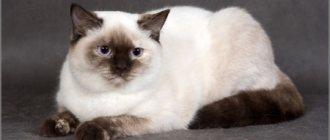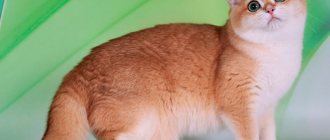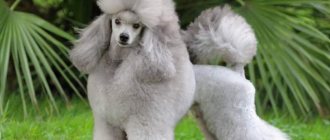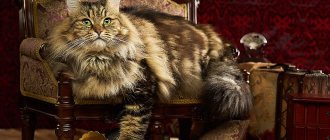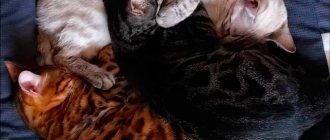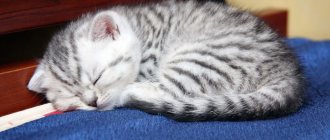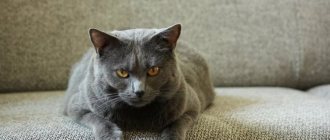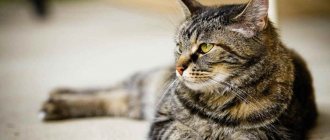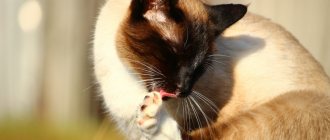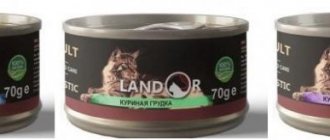Motley tricolor cats, otherwise called tortoiseshells, look very interesting and attract many lovers of mustachioed, purring pets. It is believed that a tortoiseshell cat brings good luck to the owner’s house and even attracts additional finances, and even people who do not believe in such signs are surprised to notice that with the appearance of a calico cat in their home, things are going well.
Today we will talk about how kittens get their wonderful variegated color, reminiscent of a tortoise shell, and we will tell you in which breeds animals with this coat color are found.
Tortoiseshell cat
Reasons for appearance
The reasons for such gender discrimination are based on differences in the chromosomal “complement” of males and females. The standard set of a female is XX, and in a full-fledged male it looks like XY: Y is a purely male chromosome that does not carry genes responsible, in particular, for color. But nature has outlined a clear mechanism according to which cat offspring inherit the colors of their parents.
Let's try to explain the complexities of color genetics in the simplest terms. Alleles—genes responsible for the inheritance of a particular color—can only be found on the X chromosome. Consider, for example, the black, red and white tortoiseshell pattern. Each X has one allele: B - black (b - chocolate) or O - red (o - cream). Two X+X in a cat is an opportunity to “place” both black and red colors (or their lightened versions) at the same time. But with only one X, the cat won’t be able to do this: either only black or only red.
Seals born from a tortoiseshell cat can be black or red - but not tricolor
The same scheme applies to other options, for example, blue-cream-white. White color is passed on to offspring differently, so such problems do not arise with it. White spotting (Ss) is the name of the gene that determines the inheritance of white color; it in no way depends on the sex of the animal.
Chinchillas
This type of color is similar to smoky. However, the ratio of the dark and light parts of the hair is somewhat different. Most of the hair is occupied by light color, and dark color covers only 1/8 of its length. There are two types of chinchillas: silver, in which the lower part of the hair is white, and golden, in which it is apricot-colored.
Chinchillas were bred as a result of selection of Persian tabby cats. However, the tabby pattern is as blurry as possible. The dark shade of color does not cover the entire coat. On the face and paws, for example, this shade may be only slightly noticeable. And such parts of the body as the chin, stomach, inner sides of the paws, bottom of the tail and chest are generally white, or apricot in golden chinchillas.
Is it only cats?
There is a persistent myth that only cats can be carriers of tortoiseshell coloring - due to the fact that their sex chromosomes look like XX and make it possible for both black and red colors to appear simultaneously. It is not true. It is also not entirely true that, according to statistics, for every three thousand tortoiseshell cats, only one cat of this color is born - and that one is somehow sick, defective and practically sexless.
Tortoiseshell cat or tortoiseshell cat?
The quirks of nature are much more diverse and sophisticated than our understanding. Genetic solitaire games sometimes produce unpredictable results that are difficult to explain from a scientific point of view. For example, felinologists claim that the birth rate of tricolor cats directly depends on the region of their residence - scientists have not yet found an explanation for this phenomenon. But statistics on this matter, alas, are inaccurate—systematic studies have not yet been conducted.
Tortoiseshell cats
Contrary to popular belief, tortoiseshell - calico - cats do exist. But in order for the “female” color to appear, the cat must have a certain gene anomaly: the formula of their sex chromosome set is XXY. Such males are usually sterile, although there are exceptions.
One of the most famous calico cats was born in Germany in 2014, his name is Mesomix, he is a Maine Coon, and he is very fertile. The breeding nursery is rightfully proud of this phenomenon, from where Mesomix regularly travels for matings and examinations around the world. Scientists have found out that he is a chimera cat with an XY/XY chromosome set.
Tricolor Maine Coon Mesomix - the famous chimera cat
Quite a lot of tricolor chimera cats are known. They can be anatomically and behaviorally similar to cats, practically do not mark their territory, do not react to females in heat and, accordingly, do not give birth to offspring. Calico-colored cats are more common than “tortoises”; they are usually cryptorchids - but that’s a completely different story.
Friends of the Smith family from Great Britain vying with each other to say that happiness has come to their friends’ house since a calico cat named Jake settled there. Richard Smith promised his son a kitten as a gift, and together they went to choose a purchase. My son liked the bright calico-colored baby, and for some time the whole family was sure that they had bought a cat. Only a couple of months later, during an examination by a veterinarian, it turned out that they had made a unique acquisition - a tricolor cat. He was given a new name - Jake; The cat is absolutely healthy and cheerful. And since then, good luck has come to the Smith house.
Calico cat Jake brought good luck to his owners
Since the nineteenth century, felinologists from different countries have described many tricolor cats. Unfortunately, most of them were not only sterile, but also did not live long, since along with the genetic mutation they received various serious diseases.
Tabby
There are dark spots along the body of animals of this color. These markings are not as visible as on cats with shorter hair. Tabbies are divided into types based on the shape of their spots:
- marble tabby spots in the form of patterns, the pattern is distinct, there is a spot on the forehead resembling the letter “M”, dark dots run in 2 rows from the chest to the end of the body;
- brindle tabby markings look like stripes, two rows of dark dots run from the chest to the stomach, and a continuous line stretches along the back across the entire body;
- spotted tabby spots look like stripes, but do not run in a continuous line, but are divided into several separate spots.
Among the colors are black and red.
Kinds
Felinologists distinguish two main varieties: patchwork and scaly.
Patchwork
Another name is calico. The English word "calico" means calico fabric. Calico combines clear spots of rich black, red and pure white colors and this really resembles a chintz blanket sewn from scraps.
Scaly
Another name is torti. A chaotic combination of colors is assumed here, for example, blue and cream or black and red. The spots are small, like scales, hence the name. Their boundaries are unclear, shades can flow into one another.
Standards
Based on appearance, the Persian cat is conventionally divided into 4 types:
- classic (nose located slightly below eye level);
- modern type (the edge of the nose intersects with the border of the lower eyelid, while the eyes have the shape of a circle);
- American (extreme) type: the nose is in line with the inner corners of the eyes, and seems to be concave inward;
- exotic (short-haired type): external characteristics correspond to general standards, the only difference is short hair.
| Standard | Description |
| Head | Large, dome-shaped, with a convex forehead. The cheeks are round and thick. The cheekbones are dense and powerful. The stop on the nose is clearly marked, the nose itself is wide and very short, most often snub-nosed (in individuals of the “Pekingese” type it is depressed). The muzzle is round and wide. The chin is weakly defined, the jaws are well developed. |
| Eyes | Large and round, widely spaced. The colors can be any, but, according to the standard, golden, silver and chinchilla cats should have only green shades, color-point cats should have blue shades, and Persians of any color should have orange and copper shades. |
| Ears | Small and neat, widely spaced, their tips rounded. The inner part is pubescent. |
| Neck | Short and powerful, with well-developed muscles. The body is the same: massive, with a wide back and strong bones. |
| Paws | Powerful, stocky, straight boned. The paw pads are round and elastic. Hair grows in tufts between the toes. |
| Tail | Short, outwardly proportional to the body, thick and covered with thick hair. Its tip is rounded. |
| Wool | Soft and shiny, can reach 12 cm in length on the body and up to 15 cm on the “collar”. Doesn't fit to the body. |
The disadvantages of the standard are: slanted and small eyes; a long tail; long legs and torso; long toes; oval paw shape; a long nose; large and close-set ears; narrow head.
Disqualifying signs: “medallion” on the chest; obvious jaw defects; knobby tail.
In the photo there are kittens of the Persian breed
Varieties
It’s simply hard to imagine a more bizarre color. Nature, like a careless artist, mixes colors on a palette, and sometimes jokes cheerfully, applying them to cats’ fur coats. Depending on the size, shape and location of the color spots, different types of tortoiseshell colors are classified.
Why is the color called tortoiseshell? To understand this, just look at the hair combs, which were made from tortoise shell and were once at the height of fashion.
The patterns on the tortoiseshell comb are reminiscent of the bizarre colors of turtle cats.
Full
| Color name | Wool colors | Peculiarities | Eye color |
| Tortoiseshell black | Red and black | areas with red pigment are lightened in places | dark yellow or dark copper |
| Turtle chocolate | chocolate and red | pigment saturation is usually uniform | yellow, orange or copper |
| Turtle cinnamon | red and cinnamon | color is not recognized by breed standards | yellow and dark yellow |
Tortoiseshell colors can be either spotted or striped. It is possible, although rare, to have a combination of both. It becomes the result of the interaction of “color” genes with the agouti gene (A). This is how the valuable torby color appears when the tortoiseshell spots form a tabby pattern.
The Torby color is rarely seen and is highly valued.
One color cannot combine full and diluted colors - black-cream, red-blue and similar mixes are signs of genetic mutations.
Diluted
| Color name | Wool colors | Peculiarities | Eye color |
| Tortoiseshell blue-cream | cream and blue | rare and quite sought after color | copper, green or orange |
| Tortoiseshell lilac-cream | lilac and cream | looks especially good on long thick coats | copper, green or orange |
| Tortoiseshell cream fawn | cream and fawn | color is not recognized by breed standards | green or dark yellow |
Tortoiseshell colors that have small white spots are called piebald. Such options are classified in the same way as full and diluted - only in each specific case, “with white” is added to the name of the color: for example, “cinnamon tortoiseshell with white,” tortoiseshell lilac-cream with white, etc.
Diluted tricolor colors look elegant
Colors with large areas of white are classified into a separate group called "calico". In such cases, up to half of the animal’s fur can be painted white: usually the lower part of the body along with the paws. The skin under the white fur is pink. The red and black spots on the calico's coat differ from the usual tortoiseshell color by having clearer contours and richer pigment.
Calico full
| Color name | Wool colors | Peculiarities | Eye color |
| Calico black | black, red and white | areas with red pigment are lightened in places | dark yellow or dark copper |
| Calico chocolate | chocolate, red and white | pigment saturation is usually uniform | copper, green or orange |
| Calico cinnamon | cinnamon, red and white | color is not recognized by breed standards | green or dark yellow |
With the Calico color, the black areas of the coat are uniformly colored, and the cream or red spots may be brighter in places and lighter in others; this gradation is much more noticeable than with a tortoiseshell color.
Calico varieties look brighter than tortoiseshell colors
Calico diluted
| Color name | Wool colors | Peculiarities | Eye color |
| Diluted Calico | white, cream and blue | rare and quite sought after color | copper, green or orange |
| Lilac-cream with white | white, lilac and cream | looks especially good on long thick coats | copper, green or orange |
| Cream fawn with white | white, cream and fawn | color is not recognized by breed standards | green or dark yellow |
The Calico color looks very elegant, bright and therefore very popular. It is also often called patchwork or chintz.
Smoky color
The fur of animals of this color is unevenly colored. The top half of the coat is darker than the bottom. The separation usually occurs in the middle of the hair. Sometimes the smokiness is noticeable only when the cat is moving, and when it is motionless, the color seems uniform.
Haze can have not only a black tint, but also other colors that arise when the primary colors are lightened. In addition, tortoiseshell cats can have a smoky color.
Kittens of this type often have stripes, or they have a change in the order of hair shades - the top is lighter and the bottom is dark. When they grow up, the color imperfections disappear.
Main breeds of tortoiseshell cats
The X and Y chromosomes are responsible for determining sex in cats, as in humans. The X chromosome is responsible for the inheritance of color.
For such a combination of coat colors, two X chromosomes are needed, and this is normally only possible in a female. The male has a normal cat genotype - XY. Tricolor and tortoiseshell cats are found, but this is a consequence of a genetic disorder. But they will have the XXY genotype.
Tortoiseshell cat
Interesting! It is impossible to predict whether a tortoiseshell kitten will be born to a similar cat. A litter may include a black male kitten and a red female kitten.
The following describes the most famous breeds whose coat color resembles that of a tortoiseshell.
Sphinxes
The tortoiseshell sphinx is quite rare. This color is found in the Canadian variety of this breed. Sphynxes are sophisticated and refined creatures, the cat weighs up to 4 kg, the male weighs no more than seven. The coat is completely absent.
The life expectancy of sphinxes is about 15 years, but with proper care.
The tortoiseshell color of the Sphynx cat has several varieties:
- lilac with the addition of cream;
- red chocolate;
- black-red;
- creamy blue.
Only cats are painted in this mixture of colors.
Tortoiseshell Sphynx
British
The plush fur of British cats carries different variations of “tortoiseshell” colors. The following combinations occur.
Classic common ones:
- black with red;
- lilac-cream;
- cream and blue.
Less common are British fawn (rich beige) with soft cream and cinnamon (the color of a cinnamon stick) with red splashes. Often there are combinations of tortoiseshell color with tabby (striped).
Interesting! Only cats appear this color. A tortoiseshell British cat can be born, but he will be sterile from birth.
British tortoiseshell cat
Kurilian Bobtail
Short-tailed cats with a tri-colored or blue-cream tortoiseshell coloration, come in odd-eyed, yellow-eyed and green-eyed varieties. Lilac, chocolate and fawn colors are prohibited by the breed standard. The nose and feet are gray or black.
The tortoiseshell Kurilian Bobtail should not have a coat in diluted shades of black
Japanese Bobtail
The traditional tricolor color of bobtail cats is a combination of red, black and white (except for lilac and chocolate variations). The eyes can be multi-colored (golden and blue) or all shades of orange-yellow and green. The skin of the nose and paw pads is often pink, but sometimes black.
Japanese bobtails are not allowed to have lilac and chocolate colors.
Maine Coon
Huge cats with luxurious semi-long hair, decorated with spots of various colors that smoothly flow into each other. Combinations of bright red and black with the addition of white are more common, less often diluted. The color of the skin on the soles of the paws and nose corresponds to one of the solid tones that make up the color, the eyes are greenish or yellow-orange.
Tortoiseshell Maine Coons are very common
Turkish van
On the snow-white body there are spots of black-blue and red-cream range; they should occupy no more than 15% of the cat’s body area. Eye color - blue, amber or different. The pads of the feet are pink and may have colored spots on them. The skin of the nose is deep pink.
Tortoiseshell Vans have colored spots on a white background
Persian breed
Long-haired tortoiseshell cats look very interesting, because in this case not only the pattern, but also the texture of the hairs is taken into account. In Persian cats, the tricolor sections of the coat are intricately mixed, and the hairs can have different shades along the entire length. Turtle Persians typically have beautiful dark orange eyes that look like jewels against their colorful fur.
Longhaired Persian cat "tortie"
Turkish Angora
Despite the fact that Turkish Angoras were bred as completely snow-white cats, over time, breeders introduced various types of colors, including tortoiseshell. Among Angora cats, the “tortoise-on-white” type is especially common, with the light coat having a particularly vibrant whiteness. The colored areas of the fur coat are usually bright and saturated.
Turkish Angora Tricolor
Cornish Rex
Curly-haired Cornish, which have the most delicate fur covered with curls, also represent a breed group, which according to the standard includes tortoiseshell color. Especially among Cornish Rexes, variations in coloration “turtle on white” are valued, when the lower part of the animal’s body is covered with snow-white fur, and on top there are red and black spots.
Tricolor Cornish Rex kitten
Neva Masquerade
Very dark pointing markings on the paws, muzzle, tail, as well as a beige or soft cream body. Chaotic spots from dark red to rich cream colors, sometimes the points are barely distinguishable. The nose and pads are dark brown, the irises of the eyes are painted in blue tones.
Neva Masquerade in tortoiseshell color must have blue eyes
Scottish lop-eared
Funny cats, seemingly devoid of ears, in tortoiseshell color are especially reminiscent of a forest owl. This breed is related to the British and therefore has similar types and shades of tricolor. The coat of a Scottish cat can have both cold charcoal and warm chocolate shades. More common are motley cats, the “torti” subspecies, with very rich, bright coat pigments.
Scots Fold, "torty" color
Orientals
The tortoiseshell color is one of the most popular in the rich palette of the Oriental breed - the standard allows for about four dozen color variations for these original animals. Smart and beautiful oriental cats are extraordinary in everything, from appearance to character . Therefore, the bizarre tortoiseshell patterns simply fit perfectly into the image of the breed - there is no more unusual color in nature.
Oh, who has such big ears and such a bad mood?
Norwegian
Norwegian forest cats, according to many, are the most spectacular representatives of the tortoiseshell color. Animals with the “turtle on white” type are more common. Thanks to their long, very lush and rich coat, Norwegian Forest cats boast unusual color transitions and layers of shades.
Norwegian forest turtle
Outbred
The tortoiseshell cat can be found everywhere: both in a rural farmstead and on the streets of a big city. Despite the fact that many people are happy to take tricolor kittens into their homes, many of them remain strays. Don't pass by this colorful bundle of fluffy happiness - perhaps with his appearance in your life it will change for the better.
Beauty does not require documents
It doesn’t matter whether the cat has documents - outbred “tricolors” can boast not only beauty, but also intelligence, good health and strong genetics. It is in litters of yard “turtles” that most cats are born that inherit their mother’s color.
If you're lucky, there may be several "turtle" kittens in one litter.
Health
The lifespan of Persian cats is one of the longest - with a loving owner and favorable living conditions, a cat can live more than 20 years.
Unfortunately, these cats are predisposed to hereditary diseases. Among the most popular and frequently encountered are:
- Bladder stones.
- Polycystic kidney disease.
- Cystitis.
- Congenital liver problems.
- Progressive retinal atrophy.
If any symptoms occur, treatment and even surgery are necessary. That is why potential buyers are advised to be very careful when choosing a breeder to purchase a kitten; they need to carefully check the pedigree and make sure that there have been no previous cases of the disease.
Pros and cons of the Persian breed:
Features of character and behavior
Of course, much in a cat’s character depends not on its color, but on its breed, genetics, living conditions and other factors. But in the behavior of most tortoiseshell cats, many similarities can be observed, which allows us to say: color also matters!
Tri-colored cats are unusually flexible and friendly - you can always come to an amicable agreement with them. At the same time, they are proud, independent, know what they want, and will not do what they do not like. They are persistent, and sometimes even too stubborn, and always try to get their way. However, the “turtles” are not doing this out of harm; they have a heightened sense of justice, which they try to restore wherever they are present.
A regal appearance requires aristocratic manners
The only authority for such a cat is its beloved owner. Only to him can she allow a lot and forgive him. But it is better for a stranger not to show familiarity and disrespect for such a royal person - he will instantly receive a harsh rebuff. Veterinarians say that tortoiseshell cats behave worse during appointments than all the others: well, they don’t like that the doctor takes liberties...
Of the obvious shortcomings of tricolors, only one can be named - they are poorly accustomed to the tray. If your pet has chosen a certain corner of the house to relieve itself, no force can force her to change the place for the toilet - it will be easier and more effective to move the litter tray to where she likes it. This is indeed a problem that many turtle owners complain about. Well, don’t forget to change the filling more often - a dirty tray is not suitable for royalty!
Tortoiseshell cats are caring mothers
Those who are lucky enough to own a calico cat admire its excellent maternal qualities - it turns out that color can also influence this.
How to choose a kitten
They choose a Persian kitten in specialized nurseries, only there you can buy a guaranteed healthy, purebred pet. When purchasing, follow these tips:
- In many ways, what Persian kittens will look like can be determined by the appearance of the mother cat. By examining the appearance of the parent, you can verify her health and become familiar with the living conditions of the family.
- The breeder must train the babies to use the tray, wean them from mother's milk and transfer them to independent feeding.
- Only a stronger kitten is taken from the nursery when it is more than 3 months old.
- The nursery must provide a complete package of documents with registration metrics, with attached data on vaccination, medical examination and pedigree data of at least 3 generations.
Important! Carefully examine the kitten, its ears, eyes, anus, they should all be clean and free of discharge. Skin and fur without combing or bald patches. The baby's mouth should smell good.
Persian kittens photos
How much is the breed worth?
How much a Persian cat costs depends on several conditions:
- The cheapest kittens are those bought second hand through an advertisement. Such kittens without documents and pedigree will cost approximately 2,000 rubles.
- Pet-class kittens with minor flaws from the standard cost about 7,000 rubles
- Breed-class kittens purchased for breeding will be much more expensive, starting from 15,000 rubles.
- Show-class kittens, as a show breed with an excellent pedigree, are expensive, starting from 30 thousand and above.
Nurseries
In Russia, Persian cats are popular throughout the country. Nurseries that breed exotic, classic, exotic animals of various colors exist in many cities. For example:
- Russia Moscow. "KELEVRA". Cattery, CFA registration, cats color: silver and golden chinchilla, contacts: 89639940370.
- Russia, Tver. "Ogava" Cattery, CFA and WCF registration. Exotic cats of merle, silver and bicolor colors. Contacts: 89639940370.
- Russia, Sochi. "DAIONE SIDHE". Cattery, CFA and WCF registration. Exotic cats. Contacts: 89639940370.
- Russia, Saint-Petersburg. "SILVERDOLL*RU". Cattery, CFA and WCF registration. Exotic cats. Contacts: 89639940370.
- Russia, Chelyabinsk. "Ural cloud". Cattery, CFA and WCF registration. Exotic cats. Contacts: 89058330350.
Mystical purpose
The population of different countries treats these animals differently. This is understandable: different cultures, different religions, different life interests. And what’s really surprising is that the attitude towards three-colored graceful creatures is exactly the same everywhere. I wonder why? What lies at the basis of such agreement in relation to the smaller mustachioed brothers? Cultural positions, moral and ethical standards converge at some point, and a rapprochement of peoples occurs.
The fact that feline aristocrats are endowed with different properties and given additional mystical capabilities is explained by their great rarity. Cats attract money into the house and thereby solve issues of well-being and wealth; with the help of a cat you can easily get rid of evil spirits, because this evil spirit generally cannot stand cats.
This is not a complete list of cat talents that people have endowed them with. Tortoiseshell color has nothing to do with tortoiseshell character. Tricolors are mobile, intelligent, and capable of action.
Rich is God's gift to the Russians
In Ancient Rus', animals had an additional wonderful name. They were lovingly and with a great deal of hope for all the best in life called rich people. Someone will think that the name comes from the word “wealth”, but this is not so far from the truth.
The Old Russian name for miracle cats “bogatka” comes from the word “God”. This emphasized some of the feline capabilities that God himself endowed them with.
Americans want to live well
In America, the content of the attitude towards a family friend is filled with a certain amount of practicality. Americans are sure that a tricolored, mustachioed family friend will certainly bring good luck and wealth, and will help you find and keep a well-paid job. If a person saw a tortoiseshell cat in a dream, you can be sure that happiness and good luck await you. The sign has been living in the beliefs of the peoples of the world for many centuries.
Friend of the English family
In Great Britain, the mysterious tricolor joy and comfort of the family is intended to preserve and protect the home and family from evil spirits. The British have a slightly different approach to seeing their role in family life. Tortoiseshell cats are given a special role. They are so beautiful and useful that the rest of the cat tribe is nothing compared to them. They are assigned the role of mouse exterminators. These non-tricolor fighters love only the house and themselves in this house. They do not pay any attention to the owner. A tortoiseshell cat can become a true friend to the owner of the house; comfort and tranquility, peace and harmony will reign in the house.
The Japanese worship!
The tricolor miracle has firmly taken its place in the cultural traditions of Japan. This is confirmed by the cat figurine. If you decide to purchase a figurine in Japan, you should know that there is nothing random about the figure embodied in the figurine. The tilt of the head, the size of the spots, their location - all this is of particular importance.
To choose the right figurine of an aristocrat with a tortoiseshell color, you will need to consult experts in Eastern culture. The Japanese have surpassed all nations of the world in endowing such representatives of the cat family with various positive properties. They elevated them to a symbol of the entire nation, and even called them in their own way: manekki-neko.
The Japanese are sure that three-colored creations of nature are cosmic messengers. They were sent to the planet to perform a special mission. When such a creature lives nearby, all family members will be protected from problems.
Tricolor and sailors
Swimming is reliably protected from destructive storms if they are accompanied by a tortoiseshell cat. If a sailor dreams about it, the storm will certainly stop. It is for this reason that captains carry photographs depicting a three-colored delicate creature across the seas and oceans. Like the entire cat species, tricolors are gentle, affectionate, clean, excellent mothers - like all relatives with other colors.
Care
The Persian cat can rightfully be called one of the most demanding of attention and care. What requires most attention is a chic fur coat and a balanced diet.
Wool
The most important thing in caring for a Persian cat is to understand that he will need daily care. This long, beautiful coat by itself cannot remain clean and tangled: tangles of the undercoat can form very quickly, which causes great inconvenience to the animal, and it is very difficult to comb them out.
The pet must be gently but thoroughly combed every day, first soothing it with smooth strokes, and then carefully combing it with a special long-toothed brush according to the hair growth. At the end of the procedure, you need to use a spray with an antistatic effect.
Advice! A good purchase would be a furminator - a special comb-trimmer with frequent metal teeth, which will ease the spring-autumn periods of shedding in Persians.
Bathing is not the most favorite procedure for cats, so the optimal frequency is once a month. After washing to dry, it is better to use a hairdryer on low power to avoid drafts and the likelihood of a runny nose and colds.
How to cut a Persian's hair is a very popular request; however, cats do not require a specialized haircut, but sometimes matted fur needs to be cut off. Grooming Persians can be a solution for owners and pets who live in hot and humid climates. For the summer period, the hair from the body is cut off, without affecting the head, tip of the tail and toes.
It is important to keep the litter box clean as droppings and litter pellets can get stuck in paws or on thick fur. If you don't clean it out scrupulously, the Persian may become stubborn and start shitting in the wrong place. Some Persian owners prefer to slightly shorten the hair between the toes, which reduces the problem.
Nutrition of Persian cats
Persians often have problems with the digestive tract, so their nutrition must be approached with particular seriousness.
The basis of their natural diet should consist of lean meat, which is given boiled, baked in the oven or even raw. Several times a week you can add organ meats or fish. In addition, cats also receive vegetables, most often boiled carrots, cauliflower or broccoli, zucchini and pumpkin. Be sure to add low-fat fermented milk products (yogurt, kefir, cottage cheese) to your animal’s diet.
If you decide to feed your cat natural food, then you need to additionally add age-appropriate vitamins and taurine to the diet.
Important! As an alternative, you can use ready-made food, but it is not recommended to choose manufacturers from the economy segment. What you feed your cat determines its lifespan.
Many experts believe that cats after castration are less active, eat more and begin to gain weight, but this is not entirely true. If you correctly calculate the daily ration and prepare a diet with a limited fat content, and also keep your cat busy with active games, then weight gain will not occur.
Advice! Buy stable, wide, but not very deep bowls for water and food so that your Persian is less likely to stain the hair on his face while eating.
Dry food for Persians
The Persian breed is so popular and numerous that special food is produced for Persians to maintain the beauty of the coat and its easy removal from the intestines. Popular brands:
- Royal Canin Adult Persian is a specialized food for Persians from Royal Canin.
- Pro Plan Optiderma Elegant – for healthy skin and coat.
- Grandorf Cat Indoor will not only help maintain the beauty of the coat, but will also reduce allergic reactions in cats with sensitive digestion.
- Orijen Cat 6 Fresh Fish - small granules of food are perfect for Persians with extreme stops, so cats will not need to open their mouths too much when eating. Origin belongs to the holistic class.
Caring for ears, eyes and claws
The ears should be cleaned with a cotton swab soaked in a special lotion once a week.
Since the eyes of Persian cats have specific tear ducts, they regularly secrete secretions, which is why the eyes often water. It is difficult to remove discharge without causing inconvenience to the cat, so dried crusts should be wiped with a cloth and eye care product.
Regular nail trimming is necessary for the animal; you can do this yourself using a nail clipper: you need to carefully cut off only the tip of the claw to avoid injury to the vessel inside.
Walking your pet
Persian cats are rarely taken for walks: they are calm in nature and do not want to go on a trip. It is enough for them to be in the space of the apartment, and they can watch everything that happens from an open window.
If the owner has a private house and prefers to let the cat outside, then experts recommend fencing off a section of the garden for him where he could spend time, but even in such conditions he must be constantly monitored. And don’t forget to treat your cats for ticks and worms, and for the summer, you can purchase a collar impregnated with an anti-parasite agent.
A little mysticism
Most peoples around the world endow the tortoiseshell cat with magical properties. It is believed that “turtles” attract good luck and protect the home from misfortunes. With a pet “turtle,” the house becomes cozy and calm. And if such a cat gets in by accident, then it is prohibited to kick it out. And what sane person would refuse happiness and good luck.
In Japan, such cats are iconic, they are worshiped and legends are made about them. Almost every Japanese home has a maneki-neko figurine. This is what the locals called the tortoiseshell-colored cat. They believe that such an animal is sent on a special mission and the presence of a “turtle” in the house, even in the form of a figurine, will allow them to receive the protection of higher powers. Japanese sailors are trying at any cost to get a turtle pet that will help them avoid a dangerous storm along the way.
In popular beliefs, the tortoiseshell cat is considered a symbol of grace and luck, a protector from troubles, fires and floods. “For luck” they try to take the “turtle” cat.
A colored miracle in the house will definitely become a devoted friend and bring prosperity.
conclusions
The tricolor has become a symbol of hope for the best. With its existence, people associate faith in success and luck, a prosperous family life. Everyone will be healthy and happy. Adults will always have a job and a good home. Happiness, luck and everything that is understood as a happy life were associated with such a gentle and fragile creature as a relative of lions. If such an original creature comes to the house, it is believed that happiness has come to the house.
Many peoples believed that the presence of such a cat would save them from natural disasters. It is very interesting that calico cats were considered to have greater magical power. Usually people didn’t really delve into these subtleties: the main thing was that the miracle was three-colored.
You want your home to be full of happiness and prosperity? Of course you do. Don't have a calico cat? It's time to fix the mistakes. Buy a cat like this and be happy.
Light or white cat
Lighter colored Maine Coons are suitable for calm people. White cats are always very energetic. They easily convey their good mood to their owners. Owners of light-colored cats are smiling, emotional and very active. In England, white cats are even sold in special pharmacies - for tone. By the way, healers advise everyone who has vision problems to stroke the tail of a white cat more often.
Weight table
The weight of a Persian cat ranges from 3.5 to 7 kg. Females weigh slightly less than males. Weight table for Persian cats by month
| Age | Cat | Cat |
| newborn | 90-130 gr | 100-150 gr |
| 1 month | 390-460 gr | 410-530 gr |
| 2 months | 560-920 gr | 700-1100 gr |
| 3 months | 1-1.5 kg | 1.2-2 kg |
| 4 months | 1.4-2.3 kg | 1.7-3 kg |
| 5 months | 2-2.6 kg | 2.1-3.6 kg |
| 6 months | 2.2-3.4 kg | 2.6-4.4 kg |
| 8 months | 2.7-4.2 kg | 3.6-5 kg |
| 10 months | 3-4.5 kg | 4-5.9 kg |
| 1 year | 3.5-5 kg | 4.6-6.6 kg |
| 2 years | 3.8-5 kg | 5.2-7 kg |

